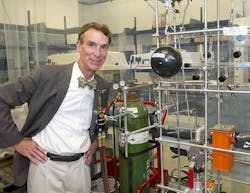Where Has All the TV Science Gone?
How do you expose kids to science? When I was young, but before I started serious science classes, it was television. Growing up, I had "Bill Nye the Science Guy," "Mr. Wizard," and "Beekman’s World." Whether it was before leaving for school or watching Saturday morning TV, it was a sure bet that I would be watching one of these shows. The thing these three shows had in common was experimentation. Each show highlighted its lessons via science experiments, many of which you could do at home. Today, however, the number of STEM shows on TV is down. The upside is that today’s media and entertainment is consumed in a variety of forms. So what used to be a TV staple for me growing up has now moved to the online arena.
Media plays an important part in children’s development. What they ingest through television and the internet helps shape their interest and their future goals. In my research for what science was on TV today, I found that it was either documentary-style, like “COSMOS” or “How It’s Made,” or cartoon shows based around STEM topics via an adventure story, like “Blaze and the Monster Machines.” Blaze and the Monster Machines are cars that have to solve mechanical problems in their adventures. While this does achieve the goal of exposing kids to STEM, it does not demonstrate the beauty of science experiments.
A recent Machine Design article about the PBS Design Squad show highlights new the venues of science media. The show was on the air from 2007 to 2009. It has now inspired a new website that involves global scientific awareness issues and ways for kids to help solve those issues. Another place to get great science is YouTube (youtube.com). There are tons of videos about science education and experimentation geared specifically for the budding scientist. Here is a list of some of my favorites:
Science Explanations
- MinutePhysics: Using a whiteboard and markers, MinutePhysics explains physics situations in quick, time-lapsed segments. Topics include why airplane engines are so big and what air is like on other planets.
- Smithsonian Science Education Center: This web series is an extension of Smithsonian’s attempts to increase STEM education in our schools. Many of the videos are geared toward classroom lessons and cover topics like atoms, cells, solar energy, and experimenting with compounds and elements.
- Kurzgesagt–In a Nutshell: This channel offers animated explanations on cosmic-level events like black holes and dark energy.
Science Experiments
- Sick Science!: Sick Science has over 200 do-it-yourself at-home science experiments that cover the whole science spectrum. Experiments range from building your own ice-tray battery, creating instant snowballs, and constructing your own light bulb.
- Cool Science Experiments Headquarters: Another DIY science channel, Cool Science also highlights experiments for the home. They range from creating your own balloon rocket to building your own tornado in a bottle.
With the recent end of “Mythbusters,” very few true experiment shows are left on television. As an engineer, it was hard to see all of those shows disappear, considering they brought to life what made engineering so much fun: the thrill of coming up with problems and solving them yourself through your own theories and experiments.
And now I’ll ask you, who are the current science role models of today and where can we turn to for science programming? Is it someone like Neil deGrasse Tyson or Bill Nye, or are there some hard-to-find-obscure science shows out there that people should tune into? Looking forward to seeing your suggestions.

